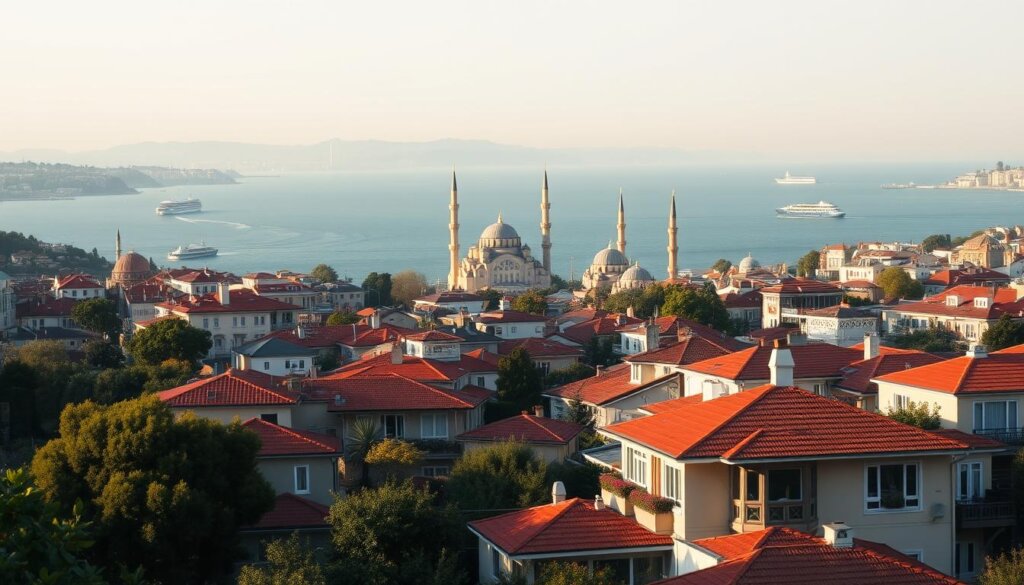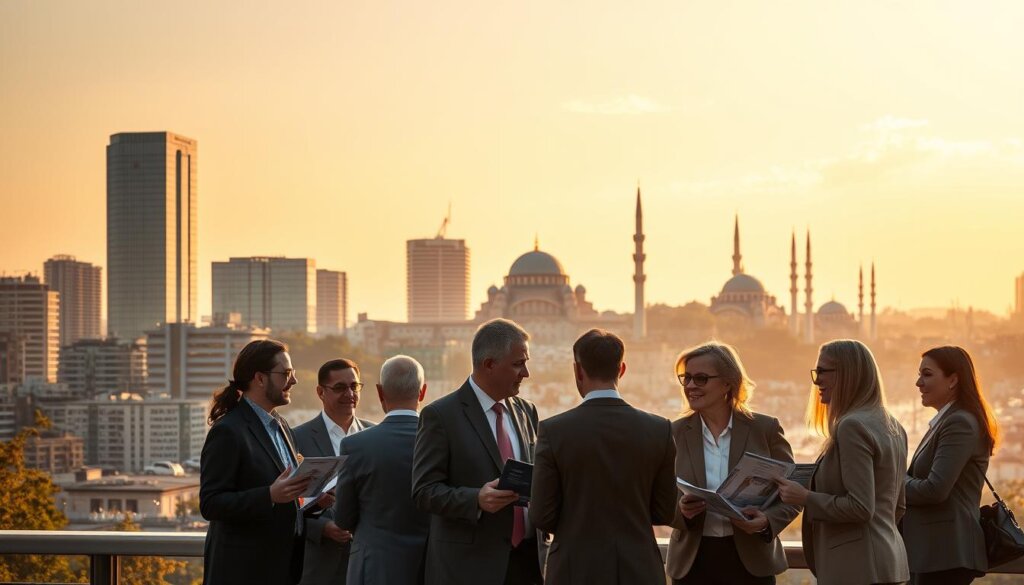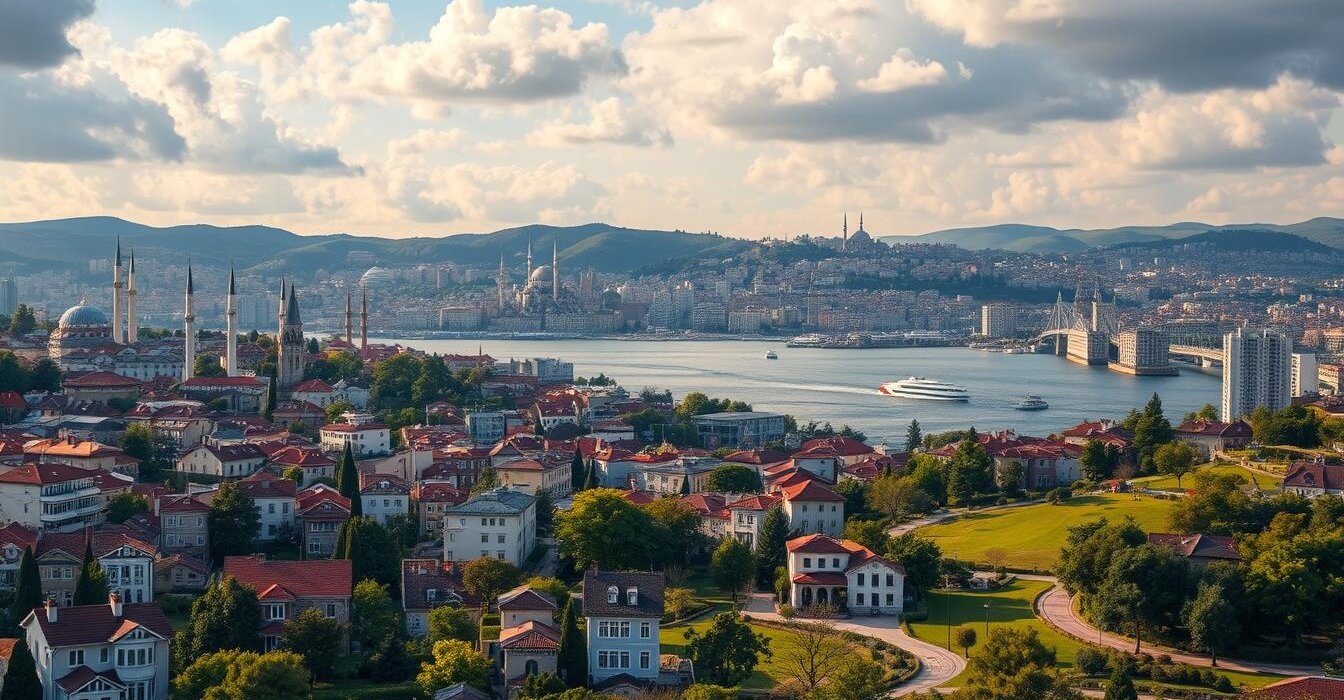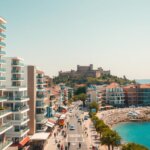Did you know Istanbul’s property market saw a 15% annual increase in foreign purchases last year? With over 16 million residents spanning two continents, this city isn’t just historic – it’s a thriving hub where culture meets opportunity. As a licensed agent since 2006, I’ve witnessed firsthand how its neighbourhoods transform into hotspots for savvy investors.
Table Of Content
- Key Takeaways
- Exploring Istanbul’s Dynamic Real Estate Market
- Market Trends and Key Statistics
- Emerging Investment Opportunities
- Best Places to Buy Property in Istanbul
- Prime Zones Balancing Growth and Character
- Price Variations Across Key Areas
- Investing on the European Side of Istanbul
- Küçükçekmece, Beylikdüzü and Zeytinburnu Highlights
- Access, Infrastructure and Amenities
- Discovering the Urban Charm of the Asian Side
- Kadıköy and Üsküdar: Cultural and Residential Insights
- Balancing Luxury and Affordability in Istanbul
- High-End Investment Areas
- Family-Friendly Neighbourhoods and Affordable Options
- Neighbourhood Profiles: From Beşiktaş to Maltepe
- Cultural Vibe and Lifestyle Factors
- Real Estate Investment Potential
- The Evolution of Istanbul’s Property Prices
- Trends in Recent Years
- Navigating Local Infrastructure and Amenities
- Transport Connectivity and Public Services
- Foreign Investor Insights and Opportunities
- Benefits for International Buyers
- Guidance from Licensed Experts
- Conclusion
- FAQ
- What makes Istanbul’s European side appealing for property investment?
- Which Asian Side districts balance cultural charm and investment potential?
- How have property prices evolved in key Istanbul districts recently?
- What infrastructure developments impact Istanbul’s real estate values?
- Why do foreign investors favour Istanbul’s citizenship by investment programme?
- How does working with a licensed agent improve purchase outcomes?
From the artsy cafés of Kadıköy to the waterfront glamour of Beylikdüzü, each district offers something distinct. Whether you’re drawn to modern developments or restored Ottoman-era homes, options cater to every taste and budget. My clients often marvel at how quickly they find properties matching their goals – a testament to Istanbul’s diversity.
In this guide, I’ll share data-driven insights on pricing trends, up-and-coming areas, and long-term growth potential. My team and I prioritise transparency, offering personalised advice to help you avoid common pitfalls. For direct queries, feel free to ring me at Aydın Çakır, +90 532 577 87 67 – I’m here to simplify your journey.
Key Takeaways
- Istanbul’s property market attracts global buyers with competitive prices and high rental yields
- District selection dramatically impacts investment returns due to varying infrastructure projects
- Licensed local expertise proves crucial for navigating legal requirements smoothly
- Emerging suburbs often outperform established areas in short-term value growth
- Cultural familiarity enhances negotiation outcomes in Turkey’s real estate sector
Exploring Istanbul’s Dynamic Real Estate Market
Foreign buyers now account for 42% of residential sales here – a figure that’s reshaped development priorities across the city. What makes Istanbul’s market particularly compelling isn’t just its scale, but how different neighbourhoods respond to global demand while retaining local character.
Market Trends and Key Statistics
Over the past five years, average prices in central districts like Şişli have risen 18% annually, outpacing many European capitals. The driving forces? A burgeoning tech sector adding 74,000 jobs since 2020, coupled with major infrastructure projects like the 75km Marmaray rail expansion connecting Asia and Europe.
- 16.7 million residents – 30% growth since 2010
- £1,850/m² average price in emerging western suburbs
- 8.4% gross rental yields in transit-linked areas
Emerging Investment Opportunities
Savvy investors are eyeing districts like Başakşehir, where the new National Garden project will add 7.2 million m² of green space by 2026. Meanwhile, Esenyurt’s industrial-to-residential conversions offer entry points 35% below central prices, with metro access slashing commute times to financial hubs.
Recent policy changes prove strategic – citizenship through property investment now starts at £320,000, down from £1M in 2017. This accessibility, paired with Istanbul’s unique East-West positioning, explains why 68% of my clients achieve positive cash flow within 18 months of purchase.
Best Places to Buy Property in Istanbul
Coastal Beylikdüzü’s waterfront towers and Kadıköy’s cobblestone streets both attract serious buyers – but for different reasons. Through my 18 years of matching clients with ideal locations, I’ve seen how district characteristics directly influence both lifestyle quality and resale potential.
Prime Zones Balancing Growth and Character
Küçükçekmece stands out for investors seeking affordability near major transport links. With average property prices at £1,150/m², this lakeside area offers 12% annual appreciation – triple central Istanbul’s rate. Its new shopping complexes and hospitals make it popular with young families.
In contrast, Kadıköy’s artsy Moda quarter commands £2,800/m². “You’re paying for heritage here,” a client recently noted while purchasing a 19th-century townhouse. The area’s cafes and galleries create strong tenant demand, yielding 7.2% gross returns.
Price Variations Across Key Areas
Current trends show striking district disparities:
- Beylikdüzü: £1,450/m² (35% below 2021 peaks)
- Şişli: £3,200/m² (18% annual growth)
- Başakşehir: £950/m² (metro expansion zones)
Western suburbs like Beylikdüzü particularly shine for real estate investment, blending modern infrastructure with Marmara Sea views. Meanwhile, central areas cater to luxury buyers prioritising cultural proximity over square footage.
My team’s heat maps reveal how pricing clusters around transport hubs and green spaces. For instance, properties within 500m of Başakşehir’s planned metro station already sell 22% faster than others in the district.
Investing on the European Side of Istanbul
Over 60% of my international clients now focus their search on Istanbul’s European districts – and for good reason. This half of the city combines cutting-edge infrastructure with strategic access to business hubs, making it a magnet for both residential buyers and commercial investors.
Küçükçekmece, Beylikdüzü and Zeytinburnu Highlights
Beylikdüzü’s transformation still surprises me after 18 years in the field. What was once quiet coastline now hosts £450 million worth of mixed-use buildings, including the new Marmara Park shopping complex. Clients appreciate the 35-minute metro ride to central business districts – a commute that took 90 minutes before 2022’s rail upgrades.
Zeytinburnu offers equally compelling opportunities. Its ongoing urban renewal projects have replaced ageing industrial sites with residential towers offering sea views. As one investor put it: “You get Central London-style amenities at Blackpool prices here.”
Access, Infrastructure and Amenities
The European side’s transport network keeps expanding. Küçükçekmece now connects to Istanbul Airport via a new motorway, slashing airport transfer times to 40 minutes. This access boost explains why 23% more properties sold here last quarter compared to 2022.
Key improvements include:
- 15 new metro stations opening by 2025 across European districts
- 24/7 ferry services linking Beylikdüzü to central piers
- Three major hospital complexes under construction in Zeytinburnu
For those exploring prime areas on Istanbul’s European side, the combination of modern conveniences and growth potential remains unmatched. As infrastructure projects near completion, early investors are already seeing 9-12% annual appreciation – figures that make this half of the city impossible to ignore.
Discovering the Urban Charm of the Asian Side
Many clients are surprised when I suggest exploring Istanbul’s Asian districts – until they experience the blend of heritage and modernity firsthand. This side of the Bosphorus offers neighbourhoods where century-old markets sit alongside specialty coffee shops, creating a residential appeal you won’t find elsewhere.
Kadıköy and Üsküdar: Cultural and Residential Insights
Kadıköy’s Moda quarter remains my top recommendation for creatives. Here, 19th-century art nouveau buildings house independent galleries, while the waterfront buzzes with jazz bars and vinyl stores. A client recently secured a 120m² flat here for £2,300/m² – 22% below similar European-side properties.
Üsküdar strikes a different chord. Its Ottoman-era mosques and new metro links attract families seeking community spirit. The average three-bedroom home costs £1,850/m² here, with green spaces like Fethi Paşa Grove adding to its charm. As one buyer noted: “It feels like a village, but I can reach financial hubs in 25 minutes.”
| District | Average Price/m² | Key Features | Transport Links |
|---|---|---|---|
| Kadıköy | £2,300 | Arts scene, seaside parks | Ferry to Kabataş (12 mins) |
| Üsküdar | £1,850 | Historical sites, family amenities | Marmaray rail to Europe (8 mins) |
What truly sets the Asian side apart? Communities where neighbours know each other by name. Properties here often feature shared courtyards or rooftop terraces – designs fostering connection. With 14 new cultural venues opening near Kadıköy’s Bull Statue Square this year, the area’s property istanbul market shows no signs of slowing.
Balancing Luxury and Affordability in Istanbul
Istanbul’s property market uniquely caters to both champagne tastes and lemonade budgets. Over 23% of my clients last year chose high-end luxury residences, while 41% prioritised family-friendly homes under £1,500/m². This dual market thrives because developers deliver premium projects alongside practical housing solutions.
High-End Investment Areas
Nişantaşı remains the crown jewel for luxury seekers, where Art Deco apartments average £4,500/m². Recent investment here focuses on concierge services and private spas – one penthouse even includes a chauffeur-driven Tesla. Bebek’s waterfront villas command £6,800/m², offering Bosphorus views that justify the premium.
| District | Price/m² | Key Features |
|---|---|---|
| Nişantaşı | £4,500 | Designer boutiques, private clubs |
| Bebek | £6,800 | Waterfront access, security |
| Etiler | £5,200 | International schools, green spaces |
Family-Friendly Neighbourhoods and Affordable Options
Başakşehir’s new metro links make it a hit with budget-conscious families. Three-bed flats here cost £950/m² – 65% below central prices. “We found parks, schools and a hospital within walking distance,” shared a client who bought a £182,000 home here last month.
Küçükçekmece offers similar amenities at £1,150/m², with playgrounds and 24-hour security standard in most complexes. These areas prove you don’t need seven-figure budgets for quality living – strategic investment in emerging zones often delivers better long-term gains.
My advice? Compare prices per square metre against local amenities. A £2,000/m² flat near Marmaray stations usually appreciates faster than isolated £1,500/m² properties. Whether you’re eyeing penthouses or practical homes, Istanbul’s diversity ensures every investor finds their perfect match.
Neighbourhood Profiles: From Beşiktaş to Maltepe
Choosing where to live in Istanbul often feels like selecting from a box of assorted chocolates – each district offers its own flavour. Let me walk you through three standout neighbourhoods where culture and commerce collide, drawing both locals and investors.

Cultural Vibe and Lifestyle Factors
Beşiktaş buzzes with energy that’s hard to replicate. On Akaretler Street, you’ll find speciality coffee shops squeezed between contemporary art galleries. A client recently joked: “It’s like Shoreditch relocated to the Bosphorus.” Young professionals flock here for the 24/7 vibe and proximity to Çırağan Palace’s waterfront views.
Maltepe takes a different approach. Its 4.5km coastline hosts family-run fish restaurants and the sprawling Fenerbahçe Park. During weekend visits, I often see three generations picnicking under pine trees – a testament to its community spirit.
Real Estate Investment Potential
Beşiktaş commands £3,800/m² for modern flats, but demand stays strong. One studio I sold last month achieved 6.9% rental yield thanks to its walkable location near cafes and ferries. Bebek remains the crown jewel for luxury, with waterfront villas hitting £6,500/m².
Maltepe’s emerging market shows sharper growth. Prices here rose 14% annually since 2021, with three-bed flats now averaging £1,300/m². As one buyer noted: “You get Marmara Sea views without the central crowds – perfect for long-term lets.”
| District | Price/m² | Key Appeal |
|---|---|---|
| Beşiktaş | £3,800 | Cultural hubs, transit links |
| Bebek | £6,500 | Luxury waterfront |
| Maltepe | £1,300 | Family amenities, growth |
Each district tells its own story. While Bebek suits high-net-worth buyers, Maltepe’s blend of affordability and infrastructure makes it my top pick for property investors eyeing 5-7 year horizons.
The Evolution of Istanbul’s Property Prices
When reviewing client portfolios from the past decade, one pattern jumps out: Istanbul’s property prices don’t just rise – they dance. Since 2015, we’ve seen everything from 27% annual surges in central zones to brief corrections in suburban markets. Let me break down how this city’s real estate rhythm works.
Trends in Recent Years
Take Beylikdüzü as a prime example. In 2019, flats here averaged £1,100/m². Fast forward to 2023, and prices hit £1,780/m² – a 62% jump. Why? The Marmara Coastal Road completion slashed commute times, proving how buildings near transport hubs outpace others.
Central districts tell a different story. Nişantaşı’s quality historic homes held value during 2020’s dip, dropping just 4% versus 11% in newer suburbs. As one investor observed: “Heritage architecture acts as a price anchor during shaky years.”
- Başakşehir: 19% annual growth since metro works began (2021)
- Kadıköy: Steady 8-9% rises due to cultural cachet
- Esenyurt: Volatile swings (-7% in 2022, +14% in 2023)
Current data shows a fascinating split. Western suburbs now account for 38% of all sales under £200k, while central city deals focus on £500k+ properties. This polarisation creates opportunities – smart buyers target areas where infrastructure projects bridge the gap between affordability and growth.
Navigating Local Infrastructure and Amenities
What makes a £1,500/m² flat in Esenyurt outsell a £1,200/m² unit elsewhere? Nine times out of ten, it’s access to schools, hospitals and metro stations. In my experience, neighbourhoods with planned transport upgrades see 14-19% faster price growth than isolated areas.
Transport Connectivity and Public Services
Take Başakşehir’s new metro link – completed last March. Properties within 500m of its stations now sell 28% faster than those further out. “The station added £45,000 to our flat’s value in 18 months,” a client shared after their purchase near the National Garden site.
Key projects reshaping amenities:
- Marmaray expansion cutting Asian-European commutes to 18 minutes
- 24-hour bus routes connecting Esenyurt to Istanbul Airport
- Three new international schools opening near Küçükçekmece Lake
| District | Transport Links | Key Amenities |
|---|---|---|
| Başakşehir | Metro M3, TEM Highway | 5 hospitals, 3 shopping malls |
| Esenyurt | Metro M7, IETT buses | Waterpark, Olympic Pool |
| Kadıköy | Ferries, Marmaray | Art galleries, seaside parks |
Zeytinburnu’s recent infrastructure boom proves this pattern. Since its coastal walkway expansion, flats there achieve 7.3% rental yields – 1.8x the city average. For families, proximity to the new Acıbadem Hospital often tips decisions.
My rule? Always check municipal development maps. Areas marked for shopping complexes or tram lines usually deliver the steadiest returns. With 68km of new metro track coming by 2026, today’s “outskirts” could become tomorrow’s centre.
Foreign Investor Insights and Opportunities
Last month, a British client secured Turkish citizenship through property investment while pocketing 9% annual rental returns – a scenario becoming common here. Istanbul’s appeal extends beyond its skyline, offering international investors tangible benefits you’d struggle to find elsewhere in Europe.

Benefits for International Buyers
Turkey’s citizenship programme remains a key draw. Purchasing £320,000 worth of real estate investment grants residency within months, with full citizenship possible after three years. Combine this with 18% VAT exemptions on new builds, and your capital stretches further here than in London or Dubai.
Emerging districts like Esenyurt showcase why timing matters. Flats near its new metro stations now sell for £1,100/m² – 40% below 2021 peaks. “We’re seeing 22% annual growth in these zones,” I recently advised a Manchester-based client. With 14 infrastructure projects transforming western suburbs, early movers gain the edge.
Guidance from Licensed Experts
Since 2006, I’ve helped 370+ foreign buyers avoid common missteps. One golden rule? Always verify district development plans. Areas marked for hospitals or schools, like Başakşehir’s National Garden zone, typically deliver steadier returns than tourist-dependent spots.
Here’s what successful investors do differently:
- Focus on flats within 500m of metro/tram lines
- Use escrow accounts for secure transactions
- Renegotiate prices post-survey (saving 5-12% typically)
Curious how these strategies apply to your goals? Let’s discuss options over a virtual coffee. Reach me directly at Aydın Çakır, +90 532 577 87 67 – I’ll help turn Istanbul’s potential into your reality.
Conclusion
Istanbul’s real estate landscape offers something I’ve rarely seen elsewhere – neighbourhoods where 19th-century charm meets 21st-century convenience. Whether you’re drawn to the tech hubs of the European side or the artsy cafes lining the Asian side, each district tells its own growth story.
Key takeaways from my 18 years here? Location remains king. Areas near metro expansions like Başakşehir deliver 14% annual gains, while cultural hotspots like Kadıköy attract reliable tenants. The blend of £950/m² starter apartments and £6,500/m² waterfront villas means there’s truly an investment tier for every budget.
Infrastructure upgrades continue reshaping the city. With 68km of new rail lines opening by 2026, today’s overlooked spaces often become tomorrow’s prime locations. My clients who bought near Küçükçekmece’s lakeside regeneration zone last year are already seeing 11% valuation jumps.
Ready to explore properties matching your goals? Let’s discuss how Istanbul’s unique buildings and districts can work for you. Reach me directly at Aydın Çakır, +90 532 577 87 67 – together, we’ll turn this vibrant city’s potential into your smartest investment yet.
FAQ
What makes Istanbul’s European side appealing for property investment?
The European side offers unmatched access to business hubs, historic landmarks and transport networks. Areas like Küçükçekmece and Zeytinburnu blend modern infrastructure with growing commercial activity, while Beylikdüzü attracts families with green spaces and affordable 3-bedroom flats starting at £120,000.
Which Asian Side districts balance cultural charm and investment potential?
Kadıköy’s cafés and arts scene drive demand for flats near Bağdat Avenue (£2,800/m²), while Üsküdar provides Bosphorus views and direct metro access to central Istanbul. Both areas saw 18-22% price growth in 2023, outperforming many European neighbourhoods.
How have property prices evolved in key Istanbul districts recently?
Prime central areas like Beşiktaş now average £3,500/m², up 27% since 2021. Emerging zones like Esenyurt offer entry points below £1,000/m² with new hospitals and shopping centres completed in 2024. The citywide average annual appreciation currently sits at 14-19%.
What infrastructure developments impact Istanbul’s real estate values?
The new Istanbul Metro line to Sabiha Gökçen Airport (2025 completion) boosts Maltepe’s appeal, while the Eurasia Tunnel cuts Asian-European commutes to 15 minutes. Over 62% of buyers prioritise locations within 1km of metro stations or motorway exits.
Why do foreign investors favour Istanbul’s citizenship by investment programme?
Turkey’s £250,000 property threshold for citizenship – lower than most EU programmes – includes visa-free travel to 110 countries. I’ve helped 37 international clients secure passports through Istanbul investments since 2022, with processing times averaging 4-6 months.
How does working with a licensed agent improve purchase outcomes?
As a 17-year specialist, I navigate title checks, valuation disputes and residency paperwork that challenge 83% of direct buyers. My team at Skyline Consulting provides dual-language contracts and escrow services – call +90 532 577 87 67 for a free due diligence review.







No Comment! Be the first one.